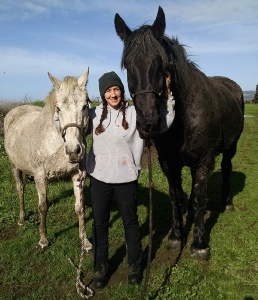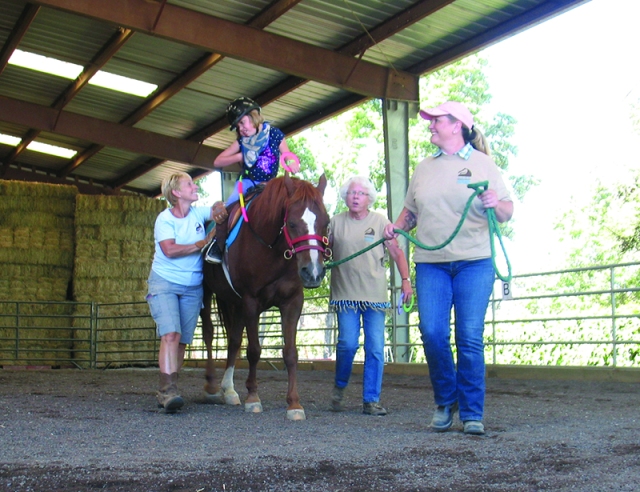by Laird Durham
When Anne Houghton, CEO of Aureole Ranch Horse Rescue, was three years old, her mother bought her a pony. So began a 35-year love affair with horses. Today, Anne cares for 16 horses, a mule, a donkey, and two goats — all of them rescued while on their way to a slaughter house.
Anne told me that some 20,000 horses are sent from California each year to slaughter houses in Canada and Mexico where they are butchered and exported as food to countries in Asia and Europe. The horses come from thoroughbred breeders and racing stables, drug production operations, riding academies, trek outfitters, cattle ranches, and private owners. Most of those horses are purchased at livestock auctions where they are bid on by “kill buyers,” fattened up in feed lots, and illegally transported to Canada or Mexico.
Aureole Ranch is a “virtual” ranch. Anne doesn’t own any land. Her horses are scattered from Southern California to Washington, where they are maintained by fosterers, and by Anne and her husband, James, who personally care for most of them at three locations in Calistoga, Petaluma, and St. Helena. Volunteers lend a hand from time to time, to feed, groom, exercise, and clean up after them. Cleaning up is a big job. A
horse puts out an average of 30 pounds of manure a day.
Anne and James have full-time day jobs. She is the tasting-room manager for the Maldonado Family Winery in Calistoga, and he is a chef for the Trinchero Estate winery in St. Helena. Much of their income goes to pay for the horse-rescue operation – literally eating up about $30,000 a year at $3 for a bale of hay. It costs $200 per month or more to board some of their horses.
Aureole Ranch Horse Rescue achieved Federal, non-profit status last year, so Anne now can offer tax deductions for foster care. They are actively seeking people to foster horses, to adopt them, to volunteer to help care for them, to provide grazing and stable facilities and, of course, to donate money for
the operation.
A Horse For Kelly To Ride
Monique Beal of Santa Rosa is one of Anne’s horse fosterers, whose daughter, Kelly, 16, is the care giver. Kelly has been riding horses since she was 5. When the Beals moved here from San Diego about a year ago, they began looking for a horse for Kelly. They met Anne through her winery job, and became fosterers for a 15-year old Saddlebred gelding named Chance, rescued from an auction. The Beals pay to board Chance at Cloverleaf Ranch, and are responsible for veterinary care and bi-monthly shoeing done by a professional farrier.
Kelly provides the care: grooming, companionship, and bathing.
Whoa! Bathing? A horse gets baths?
“Oh, yes, Kelly,” says. “Horses get dirty just like dogs, and have to be bathed. Of course, right after I give Chance a bath he goes out and rolls in dirt.”
Kelly rides Chance 3-4 days a week, so fostering is a better alternative than a riding academy. Her preference is English riding, which makes Chance’s background as a show horse a good match. Kelly does both trail riding and ring work, and has bonded well with the horse. Chance usually is in pasture when Kelly arrives at the ranch. When the horse sees her he whinnies and runs up to her at the gate.
Monique believes fostering a horse and caring for it teaches young people patience, discipline,
and respect.
It has taught Kelly a love for animals that she expects to carry over into an adult occupation: she wants to become a veterinarian. If she goes away to college in another 2 years, the Beals will return Chance to Aureole Ranch.
“If we have to give up fostering Chance I think we would continue to pay for his care,” Monique says.
Horses Are Just Big Pets
When most people think about horses they think of them for riding, racing, or working cows, along with pick-up trucks and horse trailers. But for many horse fosterers and adopters, horses are pets and companions, rarely ridden. That’s how Stacey Windbigler, 44, thinks of them. She says she spends more time telling her troubles to her big Percheron, Samson, than she does riding him. At 6 feet 2 inches tall at the shoulder, Samson towers 14 inches over Stacey. Stacey says he is the biggest horse she could find.
“I’m not the only one who thinks of horses first as pets,” Stacey says. “I see a lot of women with hay bales on their SUVs.”
As many animal owners have found, Stacey thinks owning an animal develops a bond and mutual respect. “I have learned as much about myself as I have about my horses,” Stacey says.
Stacey became a fosterer for Aureole Ranch when she was looking for a companion for Samson. She began fostering a Thoroughbred mare, Megan, rescued from an auction in Washington. Stacey and Samson became so attached to Megan that Stacey adopted her.
What is the difference between fostering and adopting? According to Stacey it is the level of commitment.
“It would be a good idea to start by fostering a horse, and then adopting later if a bond develops, and the finances work out”, she explains. It costs about $700 a month to foster or adopt a horse, including boarding charges, feed, and care from vets and farriers. Stacey spends more than that by giving her horses a lot of herbs, both Chinese and domestic.
Stacey has a deep love for animals of all kinds, developed from the time she was young in the remote mountains of Northern California where there were few kids her age. When she was 7 years old she rode steers in a rodeo, and always had dogs and cats, but never a horse. Now, besides her two horses, she has two dogs, two cats, three mini-burros, and a pond full of turtles. Stacey has two grown daughters and a ten-year-old son. Stacey and her husband are looking for 4-5 acres of land where they can build their dream house and pasture their animals.
Anne Houghton is eager to find adopters for her horses as well as fosterers. “Every horse that is adopted gives us another spot for a rescue.” she says.

